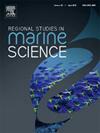微真核细胞群落随海藻生境的梯度而变化:东海典型礁岛的个案研究
IF 2.1
4区 环境科学与生态学
Q3 ECOLOGY
引用次数: 0
摘要
海藻是生态学上重要的初级生产者,形成了独特的生境。微核生物在海藻的生态功能中起着举足轻重的作用,但由于缺乏实地数据,人们对它们在海藻生境中的生态作用和过程仍然知之甚少。在此,我们利用 18S rDNA 测序技术,对一个典型的珊瑚礁岛屿--勾其岛--沿海藻生境梯度的微真核生物群落进行了创新性研究。我们利用 SCUBA(自给式水下呼吸器)从采集者处采集的碎屑样本,设置并验证了褐藻(HB,主要是马尾藻)和绿藻(HG,主要是莼菜)的生境梯度,以及它们之间的对照点(M)。在海藻栖息地沿岸,随着与海藻栖息地距离的增加,微真核细胞生物多样性从靠近海藻栖息地的残渣区下降到表层水。在主导生态功能方面,沿海藻生境梯度的底泥和水样也有明显的区别,通过曼特尔分析发现,在褐藻优势区、中等区和绿藻优势区的底泥中,分别以光养生物、混养生物和噬菌体为主,它们对环境因子和海藻的响应不同。此外,我们发现随机过程在褐藻栖息地的微真核细胞群落组合中占主导地位,而确定性过程在绿藻栖息地占主导地位。通过特异性-占位(SPEC-OCCU)分析发现,绿藻栖息地的占位差异很大。我们的研究结果有助于更好地理解海藻生境中微真核生物群落的生态功能,并进一步为海洋生态系统中海藻生境的生物评估和保护提供数据。本文章由计算机程序翻译,如有差异,请以英文原文为准。
Microeukaryotic communities varied along the gradient in the seaweed habitats: A case study in a typical reef island in the East China Sea
Seaweeds are ecologically important primary producers, forming unique habitats. Microeukaryotes are pivotal in ecological functioning of seaweeds, but their ecological role and processes in seaweed habitats remain poorly understood due to a lack of field data. Here we presented an innovative insights into the microeukaryotic communities along the seaweed habitat gradients using 18S rDNA sequencing around a typical reef island, Gouqi Island. We set and verified habitat gradients of brown (HB, mainly Sargassum) and green algae (HG, mainly Ulva), and the control site between them (M), with detritus samples collected from collectors by SCUBA (Self-Contained Underwater Breathing Apparatus). Along the seaweed habitats, microeukaryotic biodiversity decreased from the detritus close to the seaweed habitats to surface water with increasing distance from detritus. For the dominant ecological function, clear distinction was also found in detritus and water samples along the seaweed habitat gradient, where phototrophs, mixotrophs and phagotrophs dominated in the detritus of brown algae dominated site, medium site, and green algae dominated site, respectively, responding differently to the environmental factors and seaweeds by Mantel analysis. Furthermore, we found that stochastic processes dominated in microeukaryotic community assembly in the brown seaweed habitat whereas deterministic processes dominated in green algae habitat. Highly varied occupancy was revealed in the green algae habitat by Specificity-Occupancy (SPEC-OCCU) analysis. Our result contributed to a better understanding of the ecological functioning of microeukaryotic communities in seaweed habitats, and further provided data for the bioassessment and conservation of seaweed habitats within marine ecosystems.
求助全文
通过发布文献求助,成功后即可免费获取论文全文。
去求助
来源期刊

Regional Studies in Marine Science
Agricultural and Biological Sciences-Ecology, Evolution, Behavior and Systematics
CiteScore
3.90
自引率
4.80%
发文量
336
审稿时长
69 days
期刊介绍:
REGIONAL STUDIES IN MARINE SCIENCE will publish scientifically sound papers on regional aspects of maritime and marine resources in estuaries, coastal zones, continental shelf, the seas and oceans.
 求助内容:
求助内容: 应助结果提醒方式:
应助结果提醒方式:


